One of the first things you may notice during salumi making are tiny white specks on the casing of your product. These white spots are caused by mold growth on raw sausages that typically starts during fermentation.
And even though it may seem concerning, this is a completely natural part of artisanal charcuterie.
In most cases, the white mold that forms on sausage casing is completely safe. There are, however, a few exceptions you’ll need to watch out for.
In this post I’ll explain what causes white spots on meat and offer you a few ways to remove them.
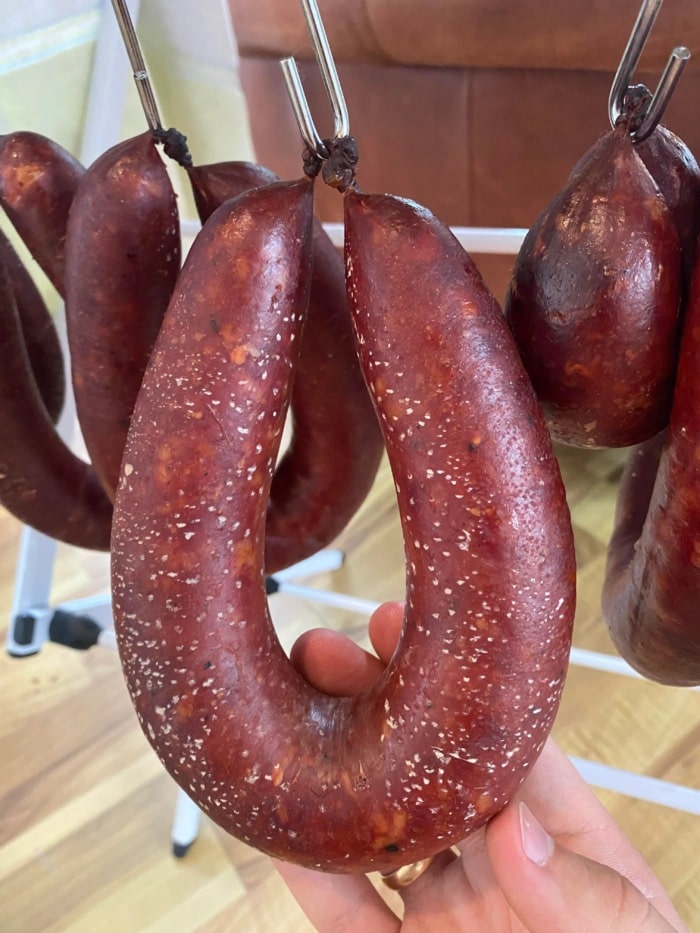
by S-M-F
What are these white spots on my sausages?
Salami making is a multi-stage process that includes curing, fermentation and aging of the meat. The aim of these procedures is to create an acidic environment that prevents the growth of harmful bacteria.
Unfortunately, none of them destroy any of the fungal spores that might be present in the storage chamber.
Which leads us to the question at hand.
During fermentation, cured sausages get exposed to a variety of fungal microorganisms in the air. When some of these microorganisms inoculate the sausage casing, they start to develop colonies that are visible as small white spots. With time, these colonies coat the sausage in a uniform white powder.
These white spots are typically caused by the Penicillium Nalgiovense fungi, but can also be the result of other fungal species from the Penicillium genus.
The best way to distinguish Nalgiovense from other white molds is by its texture.
Penicillium Nalgiovense has a chalky texture that doesn’t stain your hands and can easily be wiped off with a cloth.
Here’s how the common white mold on cured sausages looks like:
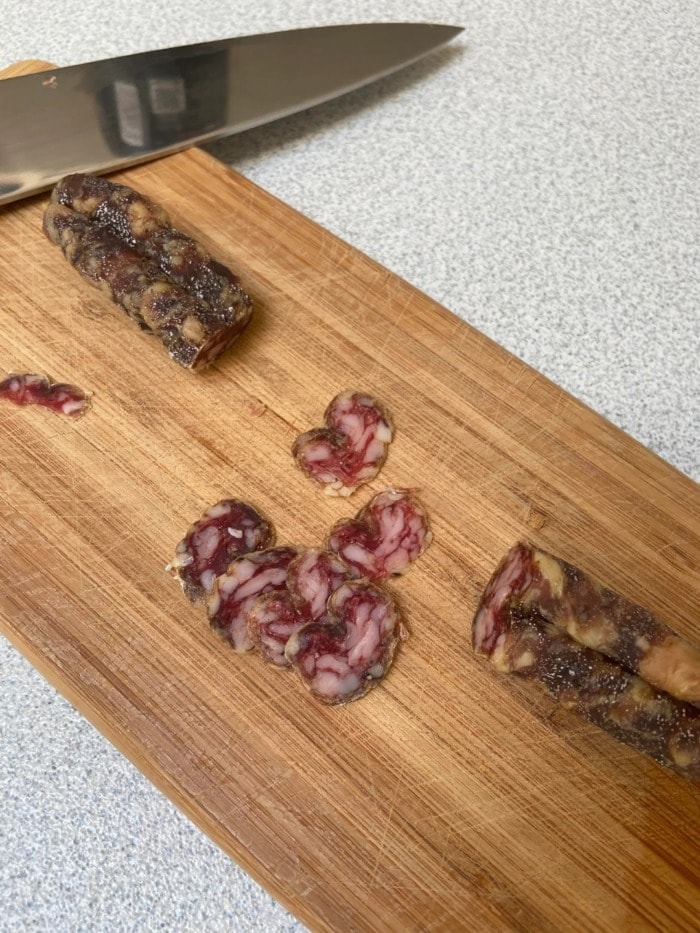
by friedchickensandwish
If your cured meat has hairy or fluffy white mold, it’s probably not Nalgiovense so it would be best to discard them.
Here’s an example of what the Nalgiovense mold might look like:
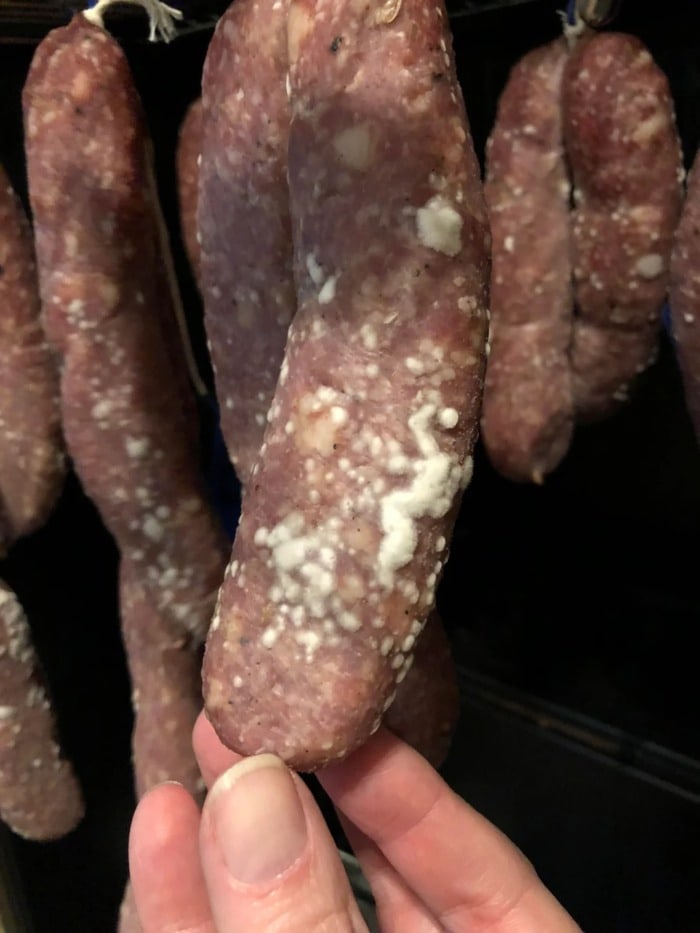
by ishouldquitsmoking
Why does this white mold commonly appear on cured meat?
Even though white mold can seem off putting, it can actually serve a purpose in salami making. Just peek into the back of any charcuterie shop and you’ll be greeted by more than a handful of dusty white salamis.
In fact, it is a sought after effect by many cured meat artisans.
There are several reasons for this.
Firstly, the growth of this type of wild mold suppresses the development of other bad molds and bacteria.
Secondly, it creates a protective barrier that insulates the meat and regulates humidity. This in turn, slows down aging and helps the meat dry more uniformly.
Lastly, white mold actually improves the flavor profile of the meat.
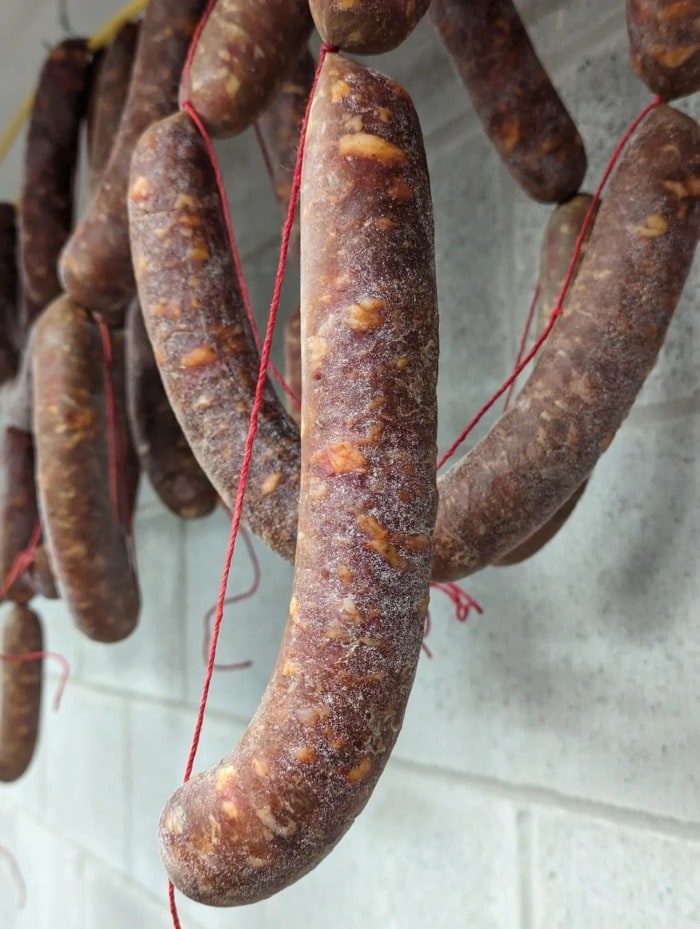
by KitchenLoavers
Is it dangerous to eat sausages with white spots on them?
Even though mold is usually associated with food spoilage, there are some types of molds that are safe to eat.
Brie and Camambert, for instance, are two of the most well known cheeses that are covered in white mold.
And according to the USDA, sausages that are covered in white spots are also completely safe for consumption.
You can even eat them along with their casing, in case it’s organic. Visit the link to learn how to distinguish edible from inedible sausage casings.
Anyhow, all of this only applies to some types of Italian, Eastern European and San Francisco salamis.
In case you notice any white spots on smoked meats such as Hot dogs or Vienna sausages, you should toss them out.
Find out: How to Cook Vienna Sausages to Your Taste?
Having said that, there are a few ways to remove white spots from sausages in case you find them unappealing.
How to remove these white spots?
There are two ways to remove white spots or mold from sausages.
The first is to brush the sausages with vinegar. Vinegar has antifungal and antibacterial properties that will destroy the fungal colonies.
You can also dip a cloth in vinegar and wipe away the mold instead of using a brush.
The downside to this method is that it has short-term effects so you’ll need to repeat it once every two days or before eating.
For a long-term fix it’s better to use a solution of potassium sorbate and water.
Potassium sorbate is a preservative that’s commonly used in the food industry.
It inhibits the growth of yeasts, bacteria and fungus which makes it great for removing any molds from a sausage.
To make the solution, you need to mix 1 oz of potassium sorbate with 10 oz of water. Afterwards, dip the sausage in the solution and let it dry. And voila! No more white spots!
Good vs bad mold on meat and how to distinguish them
The best way to distinguish good mold from bad mold on meat is by its color.
White molds
White molds typically belong to the Penicillium genus of fungi and aren’t dangerous on cured meats and aged beef.
Here’s what the good white mold looks like on the casing of a cured sausage:
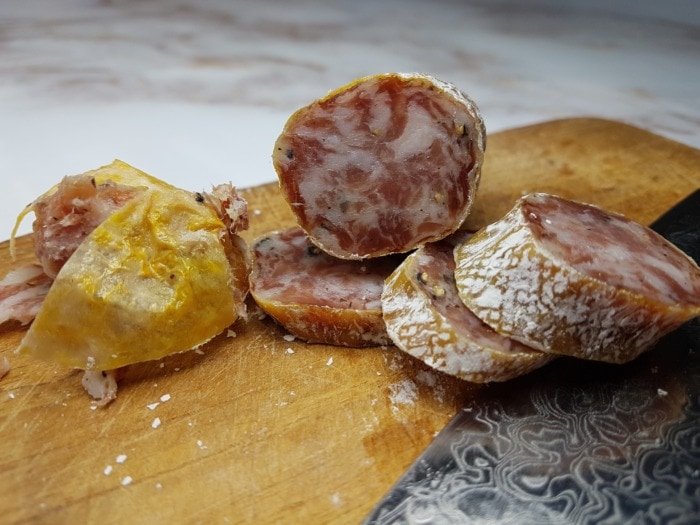
by erictheocartman_
That’s with the exception of hairy or fluffy white molds.
Here’s what the fluffy white mold that you should avoid might look like:
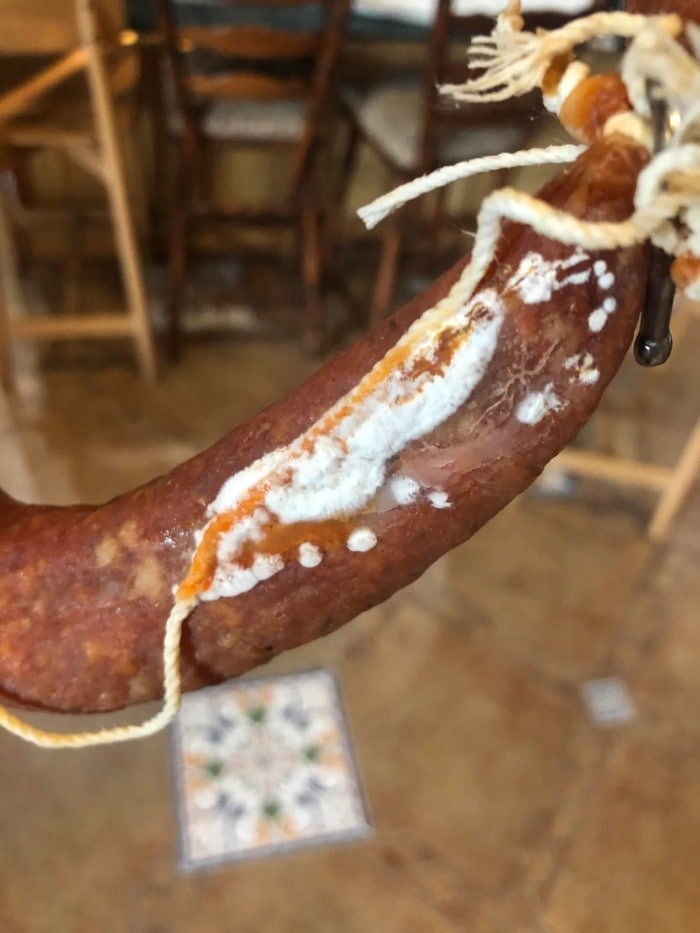
This is the bad type of white mold easily recognized by its fluffy texture – by dynastyreaper
In some cases, these molds can cause allergic reactions and respiratory problems.
Therefore, if you notice them growing on your sausages, you should avoid eating the meat.
Green molds
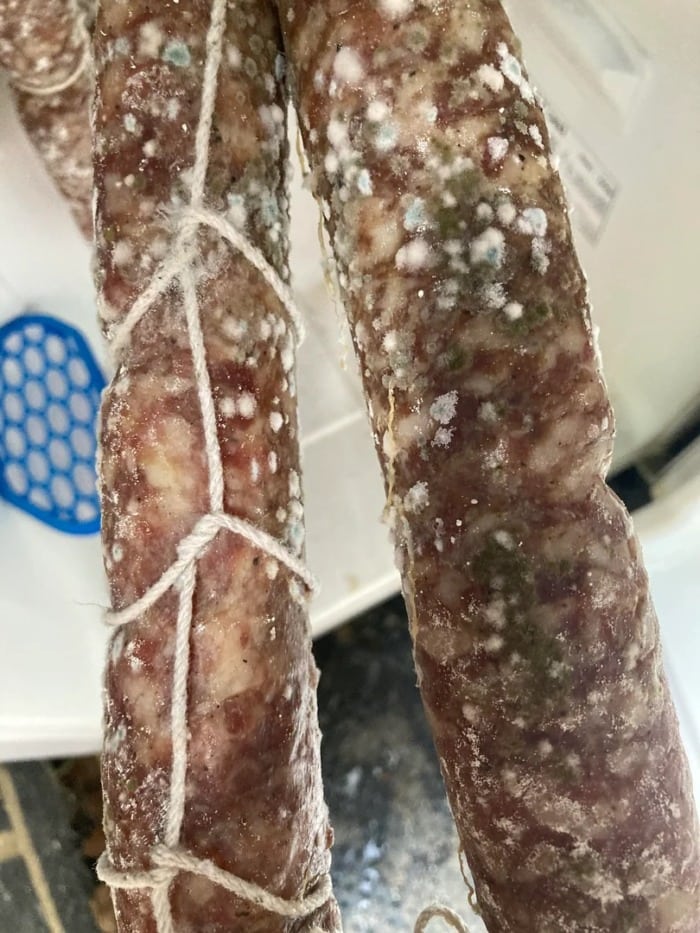
by taurine14
Green on the other hand is a color you don’t want to see on your sausages.
Most green molds are bad since they can cause food poisoning and lead to serious respiratory problems.
These molds typically develop when the humidity in the fermentation chamber is too high or there’s poor ventilation.
Fortunately, you can reduce their growth by lowering the moisture and increasing the air flow.
Another way to remove green mold from sausages is by brushing it with vinegar, as I mentioned earlier.
Having said that, sometimes green mold can be caused by a newly discovered fungus called Penicillium Salami. This type of fungi belongs to the same fungal genus as the beneficial white mold. And according to research, it’s just as safe.
Nevertheless, it’s best to avoid or remove green mold from sausages since it’s harmful in most cases.
Black molds
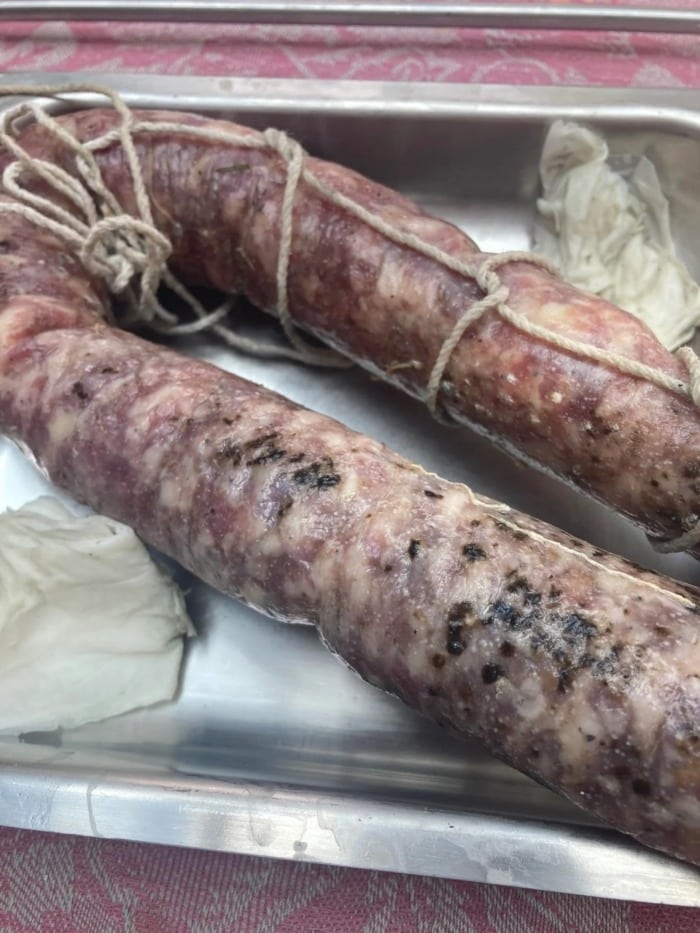
by taurine14
Black mold is another type of bad mold you can see on salami. Similarly to green mold, it tends to grow in humid conditions with little air flow.
If you notice black mold growing on your sausages, you shouldn’t try to remove it.
This type of mold produces poisonous substances that can linger even after it gets removed.
Therefore, the best course of action is to throw away the contaminated meat (Sorry!).
My Conclusion
The development of white spots on cured sausages is typically a sign of white mold growth.
When the mold has a powdery white texture it isn’t dangerous and the sausages are safe to eat.
In all other cases, it’s better to remove the mold with vinegar or avoid eating the sausages.
If you have any questions, feel free to share them down in the comments.